Analysis of Communication's Role in Group Business Decisions
VerifiedAdded on 2022/01/02
|11
|3076
|57
Report
AI Summary
This report examines the critical role of communication in group business decisions, leveraging Leximancer analytical software to analyze communication patterns in two distinct scenarios, A and B. The study highlights the importance of efficient communication for effective decision-making and business sustainability. Scenario A focuses on cluster analysis, identifying key communication nodes and their interconnections, emphasizing the significance of shared knowledge and experiences within clusters. Scenario B investigates communication dynamics between staff, customers, and management, revealing the need for improved communication channels and managerial support. The report provides recommendations for fostering open communication, empowering self-managed teams, and ensuring all staff members participate in decision-making processes to enhance business outcomes. The analysis underscores the impact of communication on sales results, customer relations, and overall organizational efficiency.

Running Head: The role of communication in group decisions 1
Name:
Title: The role of communication in group business decisions
Institution Affiliate:
Name:
Title: The role of communication in group business decisions
Institution Affiliate:
Paraphrase This Document
Need a fresh take? Get an instant paraphrase of this document with our AI Paraphraser
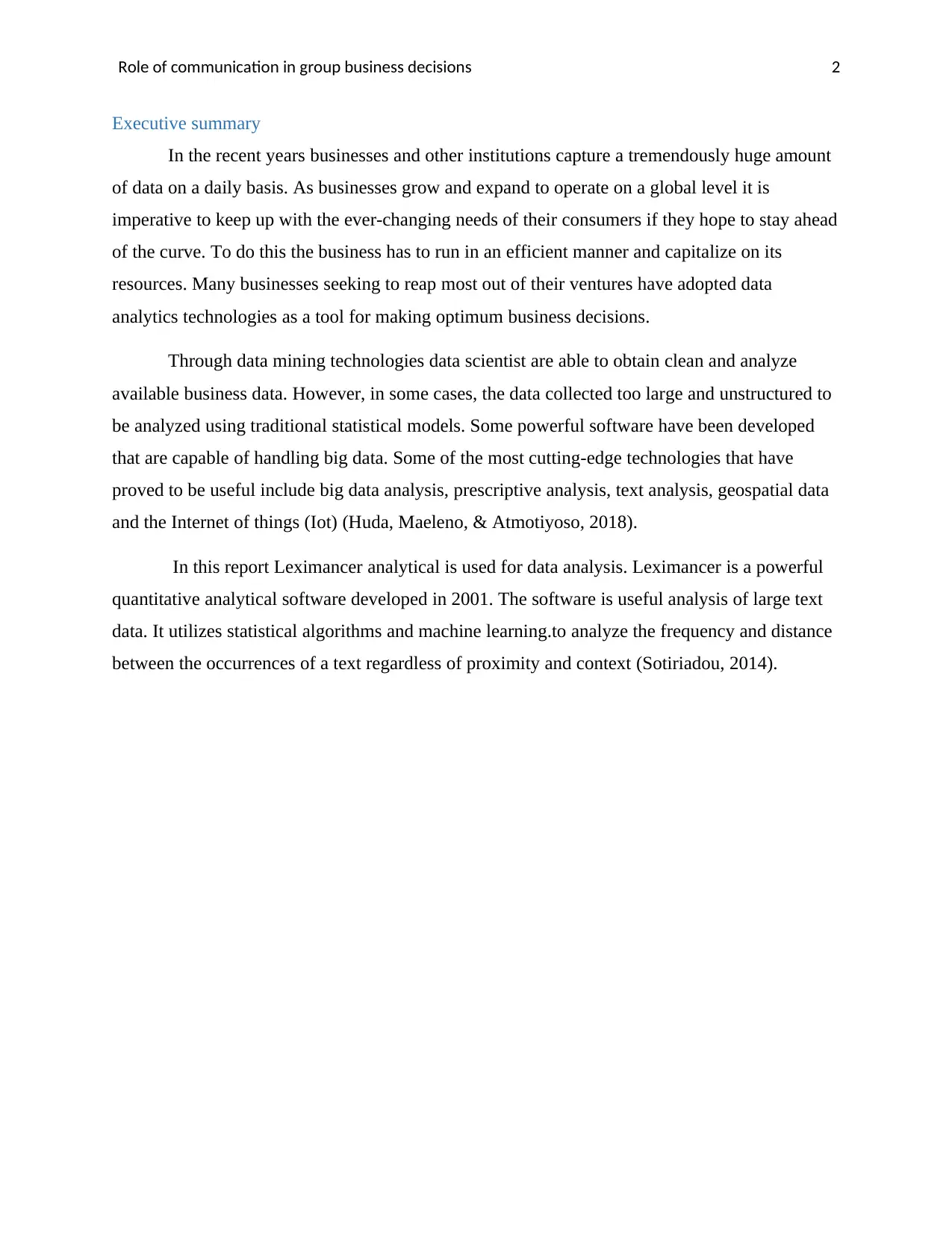
Role of communication in group business decisions 2
Executive summary
In the recent years businesses and other institutions capture a tremendously huge amount
of data on a daily basis. As businesses grow and expand to operate on a global level it is
imperative to keep up with the ever-changing needs of their consumers if they hope to stay ahead
of the curve. To do this the business has to run in an efficient manner and capitalize on its
resources. Many businesses seeking to reap most out of their ventures have adopted data
analytics technologies as a tool for making optimum business decisions.
Through data mining technologies data scientist are able to obtain clean and analyze
available business data. However, in some cases, the data collected too large and unstructured to
be analyzed using traditional statistical models. Some powerful software have been developed
that are capable of handling big data. Some of the most cutting-edge technologies that have
proved to be useful include big data analysis, prescriptive analysis, text analysis, geospatial data
and the Internet of things (Iot) (Huda, Maeleno, & Atmotiyoso, 2018).
In this report Leximancer analytical is used for data analysis. Leximancer is a powerful
quantitative analytical software developed in 2001. The software is useful analysis of large text
data. It utilizes statistical algorithms and machine learning.to analyze the frequency and distance
between the occurrences of a text regardless of proximity and context (Sotiriadou, 2014).
Executive summary
In the recent years businesses and other institutions capture a tremendously huge amount
of data on a daily basis. As businesses grow and expand to operate on a global level it is
imperative to keep up with the ever-changing needs of their consumers if they hope to stay ahead
of the curve. To do this the business has to run in an efficient manner and capitalize on its
resources. Many businesses seeking to reap most out of their ventures have adopted data
analytics technologies as a tool for making optimum business decisions.
Through data mining technologies data scientist are able to obtain clean and analyze
available business data. However, in some cases, the data collected too large and unstructured to
be analyzed using traditional statistical models. Some powerful software have been developed
that are capable of handling big data. Some of the most cutting-edge technologies that have
proved to be useful include big data analysis, prescriptive analysis, text analysis, geospatial data
and the Internet of things (Iot) (Huda, Maeleno, & Atmotiyoso, 2018).
In this report Leximancer analytical is used for data analysis. Leximancer is a powerful
quantitative analytical software developed in 2001. The software is useful analysis of large text
data. It utilizes statistical algorithms and machine learning.to analyze the frequency and distance
between the occurrences of a text regardless of proximity and context (Sotiriadou, 2014).
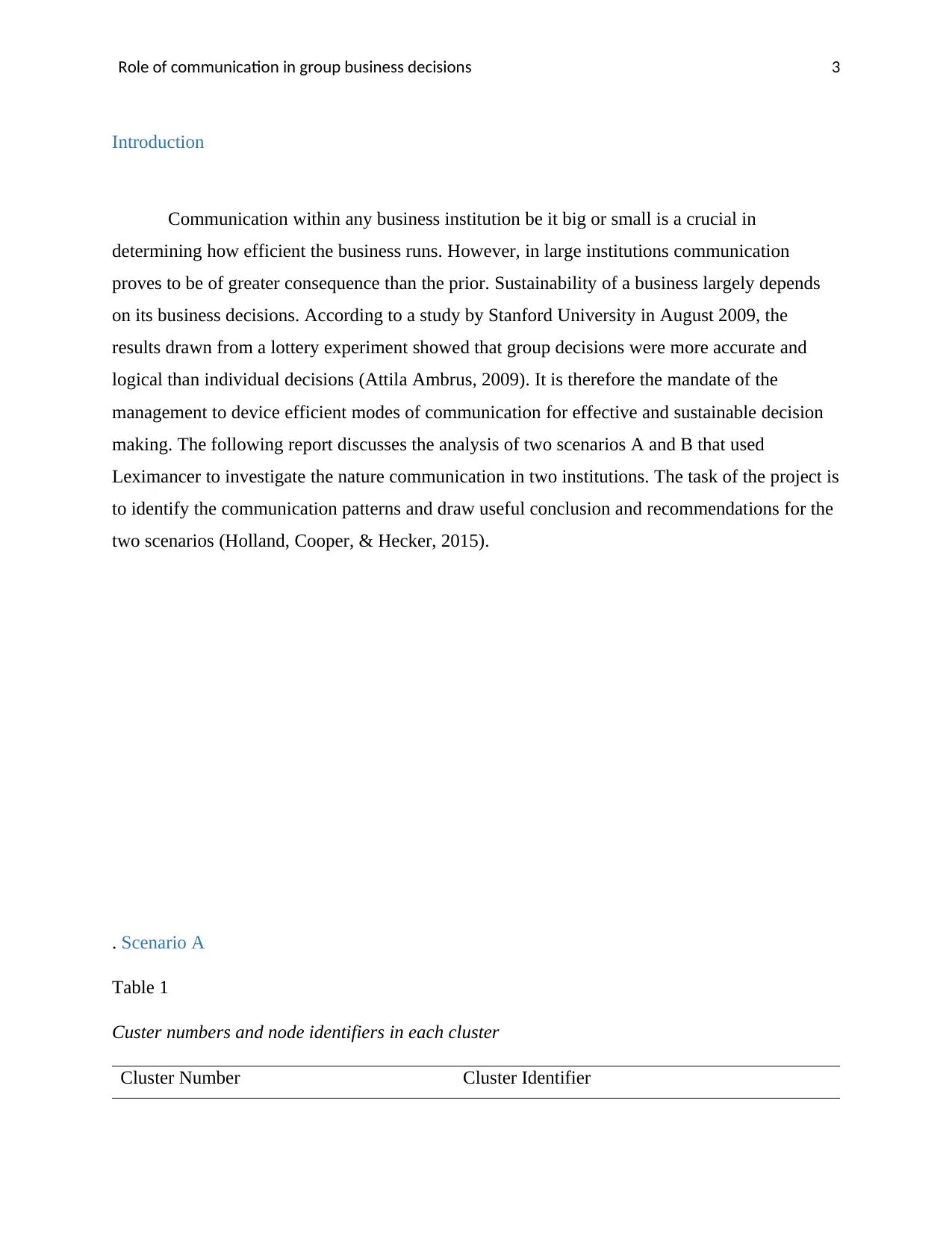
Role of communication in group business decisions 3
Introduction
Communication within any business institution be it big or small is a crucial in
determining how efficient the business runs. However, in large institutions communication
proves to be of greater consequence than the prior. Sustainability of a business largely depends
on its business decisions. According to a study by Stanford University in August 2009, the
results drawn from a lottery experiment showed that group decisions were more accurate and
logical than individual decisions (Attila Ambrus, 2009). It is therefore the mandate of the
management to device efficient modes of communication for effective and sustainable decision
making. The following report discusses the analysis of two scenarios A and B that used
Leximancer to investigate the nature communication in two institutions. The task of the project is
to identify the communication patterns and draw useful conclusion and recommendations for the
two scenarios (Holland, Cooper, & Hecker, 2015).
. Scenario A
Table 1
Custer numbers and node identifiers in each cluster
Cluster Number Cluster Identifier
Introduction
Communication within any business institution be it big or small is a crucial in
determining how efficient the business runs. However, in large institutions communication
proves to be of greater consequence than the prior. Sustainability of a business largely depends
on its business decisions. According to a study by Stanford University in August 2009, the
results drawn from a lottery experiment showed that group decisions were more accurate and
logical than individual decisions (Attila Ambrus, 2009). It is therefore the mandate of the
management to device efficient modes of communication for effective and sustainable decision
making. The following report discusses the analysis of two scenarios A and B that used
Leximancer to investigate the nature communication in two institutions. The task of the project is
to identify the communication patterns and draw useful conclusion and recommendations for the
two scenarios (Holland, Cooper, & Hecker, 2015).
. Scenario A
Table 1
Custer numbers and node identifiers in each cluster
Cluster Number Cluster Identifier
⊘ This is a preview!⊘
Do you want full access?
Subscribe today to unlock all pages.

Trusted by 1+ million students worldwide
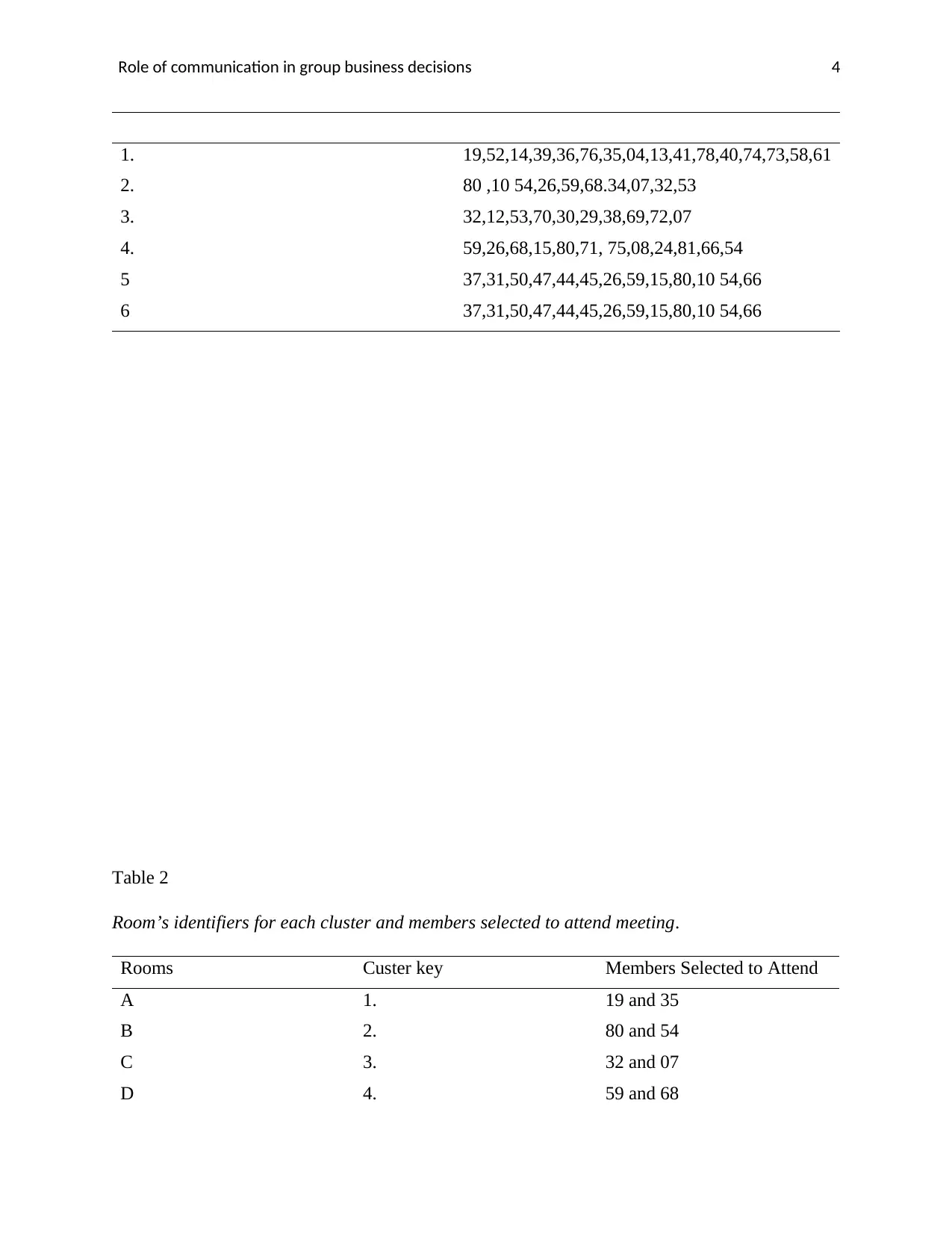
Role of communication in group business decisions 4
1. 19,52,14,39,36,76,35,04,13,41,78,40,74,73,58,61
2. 80 ,10 54,26,59,68.34,07,32,53
3. 32,12,53,70,30,29,38,69,72,07
4. 59,26,68,15,80,71, 75,08,24,81,66,54
5 37,31,50,47,44,45,26,59,15,80,10 54,66
6 37,31,50,47,44,45,26,59,15,80,10 54,66
Table 2
Room’s identifiers for each cluster and members selected to attend meeting.
Rooms Custer key Members Selected to Attend
A 1. 19 and 35
B 2. 80 and 54
C 3. 32 and 07
D 4. 59 and 68
1. 19,52,14,39,36,76,35,04,13,41,78,40,74,73,58,61
2. 80 ,10 54,26,59,68.34,07,32,53
3. 32,12,53,70,30,29,38,69,72,07
4. 59,26,68,15,80,71, 75,08,24,81,66,54
5 37,31,50,47,44,45,26,59,15,80,10 54,66
6 37,31,50,47,44,45,26,59,15,80,10 54,66
Table 2
Room’s identifiers for each cluster and members selected to attend meeting.
Rooms Custer key Members Selected to Attend
A 1. 19 and 35
B 2. 80 and 54
C 3. 32 and 07
D 4. 59 and 68
Paraphrase This Document
Need a fresh take? Get an instant paraphrase of this document with our AI Paraphraser
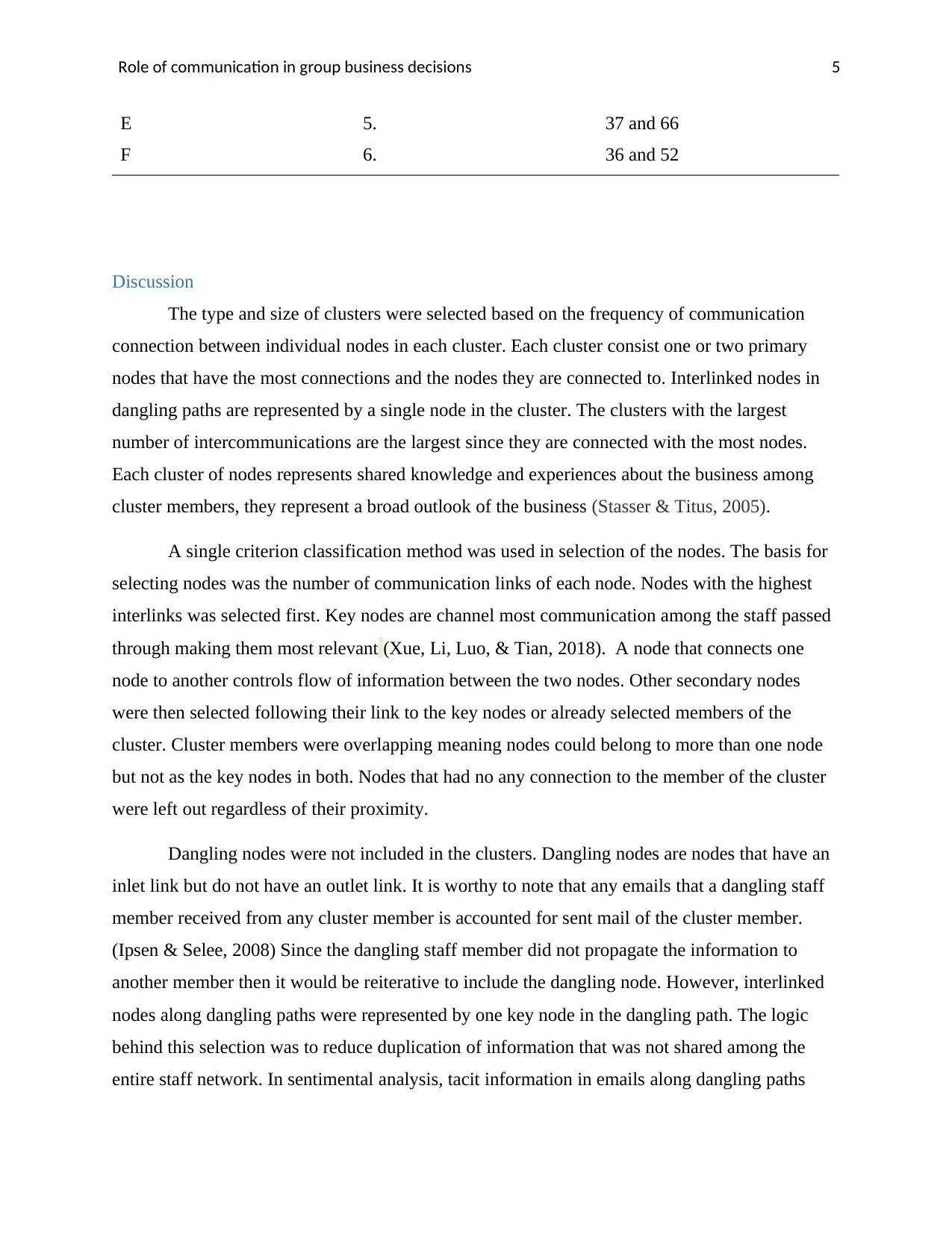
Role of communication in group business decisions 5
E 5. 37 and 66
F 6. 36 and 52
Discussion
The type and size of clusters were selected based on the frequency of communication
connection between individual nodes in each cluster. Each cluster consist one or two primary
nodes that have the most connections and the nodes they are connected to. Interlinked nodes in
dangling paths are represented by a single node in the cluster. The clusters with the largest
number of intercommunications are the largest since they are connected with the most nodes.
Each cluster of nodes represents shared knowledge and experiences about the business among
cluster members, they represent a broad outlook of the business (Stasser & Titus, 2005).
A single criterion classification method was used in selection of the nodes. The basis for
selecting nodes was the number of communication links of each node. Nodes with the highest
interlinks was selected first. Key nodes are channel most communication among the staff passed
through making them most relevant (Xue, Li, Luo, & Tian, 2018). A node that connects one
node to another controls flow of information between the two nodes. Other secondary nodes
were then selected following their link to the key nodes or already selected members of the
cluster. Cluster members were overlapping meaning nodes could belong to more than one node
but not as the key nodes in both. Nodes that had no any connection to the member of the cluster
were left out regardless of their proximity.
Dangling nodes were not included in the clusters. Dangling nodes are nodes that have an
inlet link but do not have an outlet link. It is worthy to note that any emails that a dangling staff
member received from any cluster member is accounted for sent mail of the cluster member.
(Ipsen & Selee, 2008) Since the dangling staff member did not propagate the information to
another member then it would be reiterative to include the dangling node. However, interlinked
nodes along dangling paths were represented by one key node in the dangling path. The logic
behind this selection was to reduce duplication of information that was not shared among the
entire staff network. In sentimental analysis, tacit information in emails along dangling paths
E 5. 37 and 66
F 6. 36 and 52
Discussion
The type and size of clusters were selected based on the frequency of communication
connection between individual nodes in each cluster. Each cluster consist one or two primary
nodes that have the most connections and the nodes they are connected to. Interlinked nodes in
dangling paths are represented by a single node in the cluster. The clusters with the largest
number of intercommunications are the largest since they are connected with the most nodes.
Each cluster of nodes represents shared knowledge and experiences about the business among
cluster members, they represent a broad outlook of the business (Stasser & Titus, 2005).
A single criterion classification method was used in selection of the nodes. The basis for
selecting nodes was the number of communication links of each node. Nodes with the highest
interlinks was selected first. Key nodes are channel most communication among the staff passed
through making them most relevant (Xue, Li, Luo, & Tian, 2018). A node that connects one
node to another controls flow of information between the two nodes. Other secondary nodes
were then selected following their link to the key nodes or already selected members of the
cluster. Cluster members were overlapping meaning nodes could belong to more than one node
but not as the key nodes in both. Nodes that had no any connection to the member of the cluster
were left out regardless of their proximity.
Dangling nodes were not included in the clusters. Dangling nodes are nodes that have an
inlet link but do not have an outlet link. It is worthy to note that any emails that a dangling staff
member received from any cluster member is accounted for sent mail of the cluster member.
(Ipsen & Selee, 2008) Since the dangling staff member did not propagate the information to
another member then it would be reiterative to include the dangling node. However, interlinked
nodes along dangling paths were represented by one key node in the dangling path. The logic
behind this selection was to reduce duplication of information that was not shared among the
entire staff network. In sentimental analysis, tacit information in emails along dangling paths
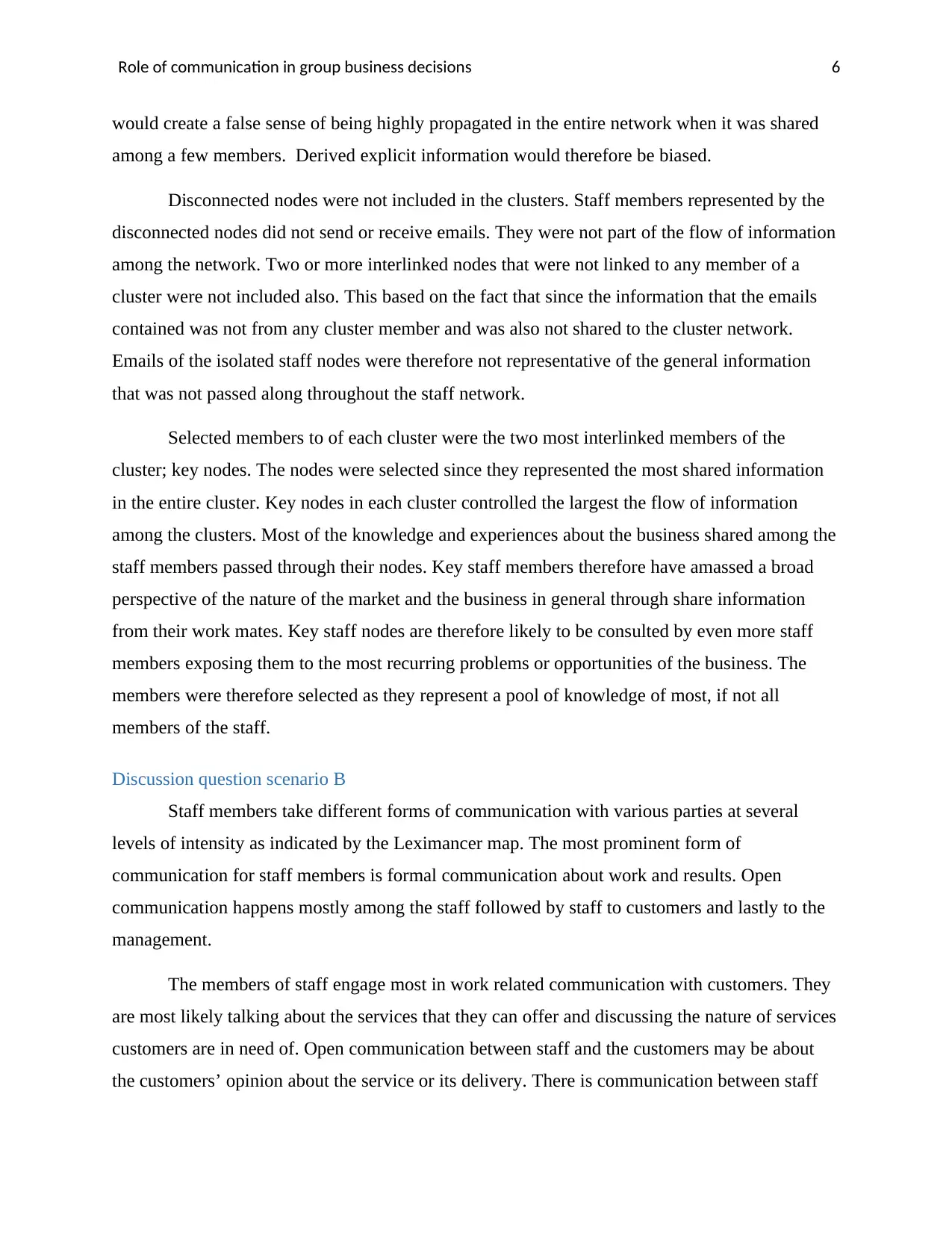
Role of communication in group business decisions 6
would create a false sense of being highly propagated in the entire network when it was shared
among a few members. Derived explicit information would therefore be biased.
Disconnected nodes were not included in the clusters. Staff members represented by the
disconnected nodes did not send or receive emails. They were not part of the flow of information
among the network. Two or more interlinked nodes that were not linked to any member of a
cluster were not included also. This based on the fact that since the information that the emails
contained was not from any cluster member and was also not shared to the cluster network.
Emails of the isolated staff nodes were therefore not representative of the general information
that was not passed along throughout the staff network.
Selected members to of each cluster were the two most interlinked members of the
cluster; key nodes. The nodes were selected since they represented the most shared information
in the entire cluster. Key nodes in each cluster controlled the largest the flow of information
among the clusters. Most of the knowledge and experiences about the business shared among the
staff members passed through their nodes. Key staff members therefore have amassed a broad
perspective of the nature of the market and the business in general through share information
from their work mates. Key staff nodes are therefore likely to be consulted by even more staff
members exposing them to the most recurring problems or opportunities of the business. The
members were therefore selected as they represent a pool of knowledge of most, if not all
members of the staff.
Discussion question scenario B
Staff members take different forms of communication with various parties at several
levels of intensity as indicated by the Leximancer map. The most prominent form of
communication for staff members is formal communication about work and results. Open
communication happens mostly among the staff followed by staff to customers and lastly to the
management.
The members of staff engage most in work related communication with customers. They
are most likely talking about the services that they can offer and discussing the nature of services
customers are in need of. Open communication between staff and the customers may be about
the customers’ opinion about the service or its delivery. There is communication between staff
would create a false sense of being highly propagated in the entire network when it was shared
among a few members. Derived explicit information would therefore be biased.
Disconnected nodes were not included in the clusters. Staff members represented by the
disconnected nodes did not send or receive emails. They were not part of the flow of information
among the network. Two or more interlinked nodes that were not linked to any member of a
cluster were not included also. This based on the fact that since the information that the emails
contained was not from any cluster member and was also not shared to the cluster network.
Emails of the isolated staff nodes were therefore not representative of the general information
that was not passed along throughout the staff network.
Selected members to of each cluster were the two most interlinked members of the
cluster; key nodes. The nodes were selected since they represented the most shared information
in the entire cluster. Key nodes in each cluster controlled the largest the flow of information
among the clusters. Most of the knowledge and experiences about the business shared among the
staff members passed through their nodes. Key staff members therefore have amassed a broad
perspective of the nature of the market and the business in general through share information
from their work mates. Key staff nodes are therefore likely to be consulted by even more staff
members exposing them to the most recurring problems or opportunities of the business. The
members were therefore selected as they represent a pool of knowledge of most, if not all
members of the staff.
Discussion question scenario B
Staff members take different forms of communication with various parties at several
levels of intensity as indicated by the Leximancer map. The most prominent form of
communication for staff members is formal communication about work and results. Open
communication happens mostly among the staff followed by staff to customers and lastly to the
management.
The members of staff engage most in work related communication with customers. They
are most likely talking about the services that they can offer and discussing the nature of services
customers are in need of. Open communication between staff and the customers may be about
the customers’ opinion about the service or its delivery. There is communication between staff
⊘ This is a preview!⊘
Do you want full access?
Subscribe today to unlock all pages.

Trusted by 1+ million students worldwide
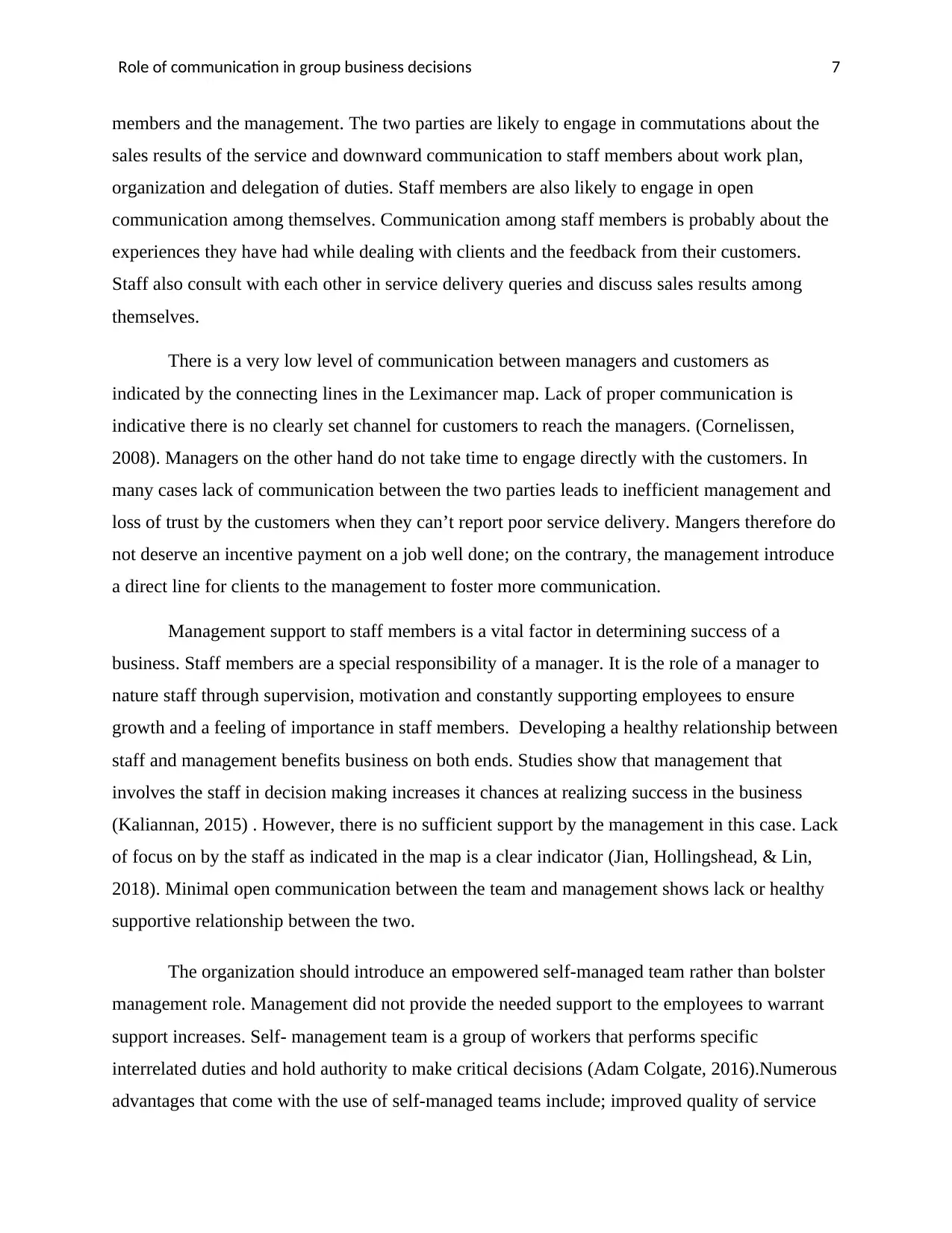
Role of communication in group business decisions 7
members and the management. The two parties are likely to engage in commutations about the
sales results of the service and downward communication to staff members about work plan,
organization and delegation of duties. Staff members are also likely to engage in open
communication among themselves. Communication among staff members is probably about the
experiences they have had while dealing with clients and the feedback from their customers.
Staff also consult with each other in service delivery queries and discuss sales results among
themselves.
There is a very low level of communication between managers and customers as
indicated by the connecting lines in the Leximancer map. Lack of proper communication is
indicative there is no clearly set channel for customers to reach the managers. (Cornelissen,
2008). Managers on the other hand do not take time to engage directly with the customers. In
many cases lack of communication between the two parties leads to inefficient management and
loss of trust by the customers when they can’t report poor service delivery. Mangers therefore do
not deserve an incentive payment on a job well done; on the contrary, the management introduce
a direct line for clients to the management to foster more communication.
Management support to staff members is a vital factor in determining success of a
business. Staff members are a special responsibility of a manager. It is the role of a manager to
nature staff through supervision, motivation and constantly supporting employees to ensure
growth and a feeling of importance in staff members. Developing a healthy relationship between
staff and management benefits business on both ends. Studies show that management that
involves the staff in decision making increases it chances at realizing success in the business
(Kaliannan, 2015) . However, there is no sufficient support by the management in this case. Lack
of focus on by the staff as indicated in the map is a clear indicator (Jian, Hollingshead, & Lin,
2018). Minimal open communication between the team and management shows lack or healthy
supportive relationship between the two.
The organization should introduce an empowered self-managed team rather than bolster
management role. Management did not provide the needed support to the employees to warrant
support increases. Self- management team is a group of workers that performs specific
interrelated duties and hold authority to make critical decisions (Adam Colgate, 2016).Numerous
advantages that come with the use of self-managed teams include; improved quality of service
members and the management. The two parties are likely to engage in commutations about the
sales results of the service and downward communication to staff members about work plan,
organization and delegation of duties. Staff members are also likely to engage in open
communication among themselves. Communication among staff members is probably about the
experiences they have had while dealing with clients and the feedback from their customers.
Staff also consult with each other in service delivery queries and discuss sales results among
themselves.
There is a very low level of communication between managers and customers as
indicated by the connecting lines in the Leximancer map. Lack of proper communication is
indicative there is no clearly set channel for customers to reach the managers. (Cornelissen,
2008). Managers on the other hand do not take time to engage directly with the customers. In
many cases lack of communication between the two parties leads to inefficient management and
loss of trust by the customers when they can’t report poor service delivery. Mangers therefore do
not deserve an incentive payment on a job well done; on the contrary, the management introduce
a direct line for clients to the management to foster more communication.
Management support to staff members is a vital factor in determining success of a
business. Staff members are a special responsibility of a manager. It is the role of a manager to
nature staff through supervision, motivation and constantly supporting employees to ensure
growth and a feeling of importance in staff members. Developing a healthy relationship between
staff and management benefits business on both ends. Studies show that management that
involves the staff in decision making increases it chances at realizing success in the business
(Kaliannan, 2015) . However, there is no sufficient support by the management in this case. Lack
of focus on by the staff as indicated in the map is a clear indicator (Jian, Hollingshead, & Lin,
2018). Minimal open communication between the team and management shows lack or healthy
supportive relationship between the two.
The organization should introduce an empowered self-managed team rather than bolster
management role. Management did not provide the needed support to the employees to warrant
support increases. Self- management team is a group of workers that performs specific
interrelated duties and hold authority to make critical decisions (Adam Colgate, 2016).Numerous
advantages that come with the use of self-managed teams include; improved quality of service
Paraphrase This Document
Need a fresh take? Get an instant paraphrase of this document with our AI Paraphraser
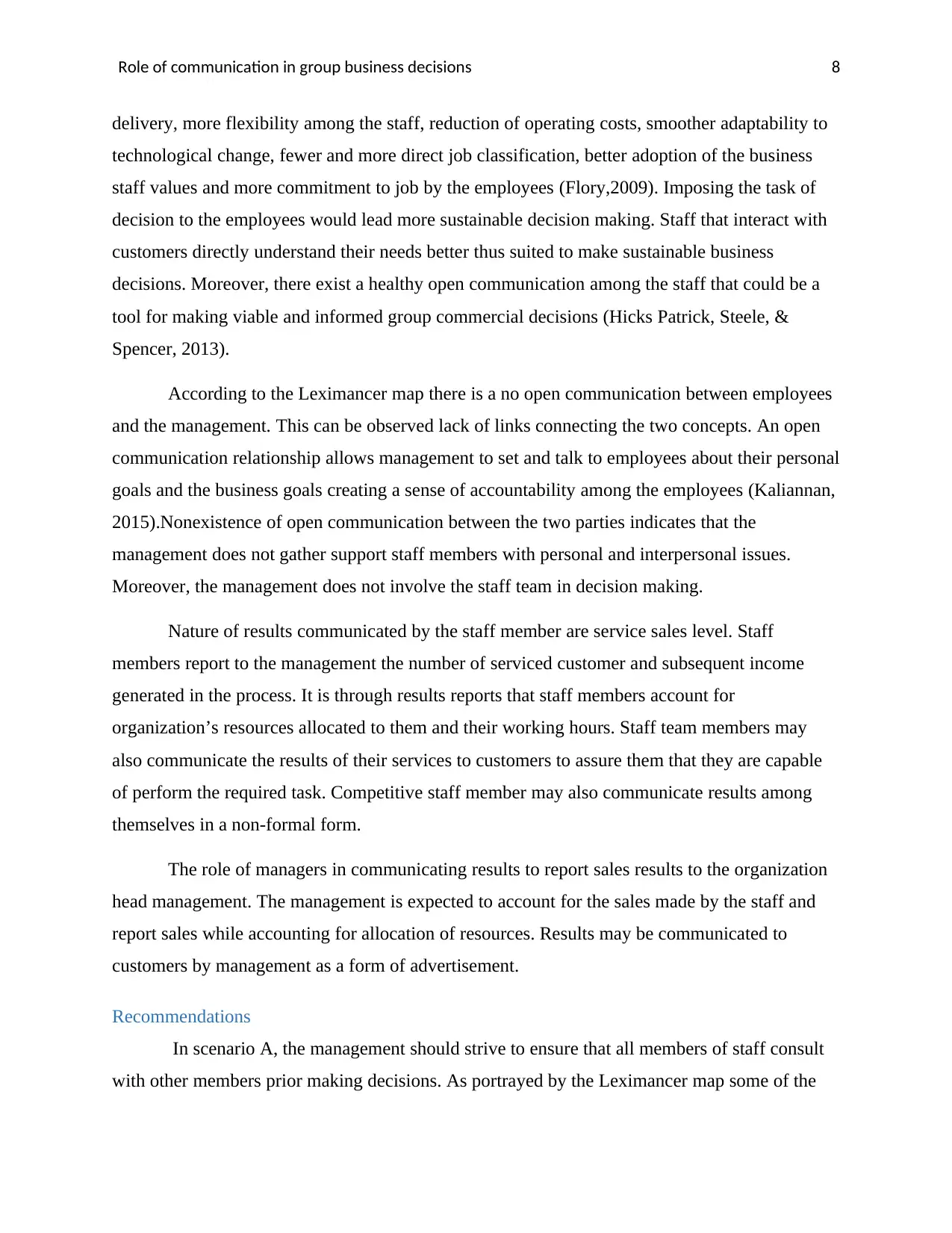
Role of communication in group business decisions 8
delivery, more flexibility among the staff, reduction of operating costs, smoother adaptability to
technological change, fewer and more direct job classification, better adoption of the business
staff values and more commitment to job by the employees (Flory,2009). Imposing the task of
decision to the employees would lead more sustainable decision making. Staff that interact with
customers directly understand their needs better thus suited to make sustainable business
decisions. Moreover, there exist a healthy open communication among the staff that could be a
tool for making viable and informed group commercial decisions (Hicks Patrick, Steele, &
Spencer, 2013).
According to the Leximancer map there is a no open communication between employees
and the management. This can be observed lack of links connecting the two concepts. An open
communication relationship allows management to set and talk to employees about their personal
goals and the business goals creating a sense of accountability among the employees (Kaliannan,
2015).Nonexistence of open communication between the two parties indicates that the
management does not gather support staff members with personal and interpersonal issues.
Moreover, the management does not involve the staff team in decision making.
Nature of results communicated by the staff member are service sales level. Staff
members report to the management the number of serviced customer and subsequent income
generated in the process. It is through results reports that staff members account for
organization’s resources allocated to them and their working hours. Staff team members may
also communicate the results of their services to customers to assure them that they are capable
of perform the required task. Competitive staff member may also communicate results among
themselves in a non-formal form.
The role of managers in communicating results to report sales results to the organization
head management. The management is expected to account for the sales made by the staff and
report sales while accounting for allocation of resources. Results may be communicated to
customers by management as a form of advertisement.
Recommendations
In scenario A, the management should strive to ensure that all members of staff consult
with other members prior making decisions. As portrayed by the Leximancer map some of the
delivery, more flexibility among the staff, reduction of operating costs, smoother adaptability to
technological change, fewer and more direct job classification, better adoption of the business
staff values and more commitment to job by the employees (Flory,2009). Imposing the task of
decision to the employees would lead more sustainable decision making. Staff that interact with
customers directly understand their needs better thus suited to make sustainable business
decisions. Moreover, there exist a healthy open communication among the staff that could be a
tool for making viable and informed group commercial decisions (Hicks Patrick, Steele, &
Spencer, 2013).
According to the Leximancer map there is a no open communication between employees
and the management. This can be observed lack of links connecting the two concepts. An open
communication relationship allows management to set and talk to employees about their personal
goals and the business goals creating a sense of accountability among the employees (Kaliannan,
2015).Nonexistence of open communication between the two parties indicates that the
management does not gather support staff members with personal and interpersonal issues.
Moreover, the management does not involve the staff team in decision making.
Nature of results communicated by the staff member are service sales level. Staff
members report to the management the number of serviced customer and subsequent income
generated in the process. It is through results reports that staff members account for
organization’s resources allocated to them and their working hours. Staff team members may
also communicate the results of their services to customers to assure them that they are capable
of perform the required task. Competitive staff member may also communicate results among
themselves in a non-formal form.
The role of managers in communicating results to report sales results to the organization
head management. The management is expected to account for the sales made by the staff and
report sales while accounting for allocation of resources. Results may be communicated to
customers by management as a form of advertisement.
Recommendations
In scenario A, the management should strive to ensure that all members of staff consult
with other members prior making decisions. As portrayed by the Leximancer map some of the
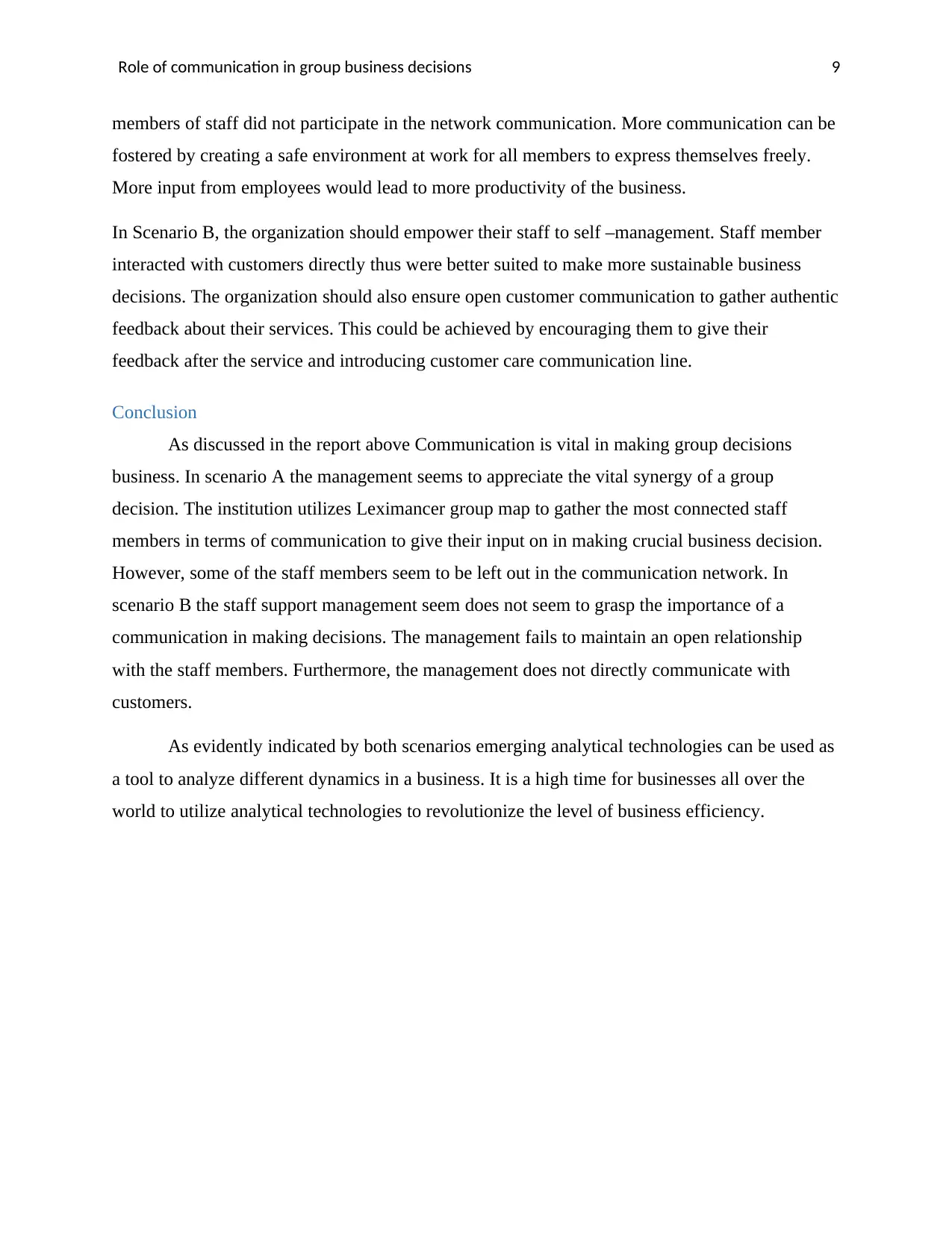
Role of communication in group business decisions 9
members of staff did not participate in the network communication. More communication can be
fostered by creating a safe environment at work for all members to express themselves freely.
More input from employees would lead to more productivity of the business.
In Scenario B, the organization should empower their staff to self –management. Staff member
interacted with customers directly thus were better suited to make more sustainable business
decisions. The organization should also ensure open customer communication to gather authentic
feedback about their services. This could be achieved by encouraging them to give their
feedback after the service and introducing customer care communication line.
Conclusion
As discussed in the report above Communication is vital in making group decisions
business. In scenario A the management seems to appreciate the vital synergy of a group
decision. The institution utilizes Leximancer group map to gather the most connected staff
members in terms of communication to give their input on in making crucial business decision.
However, some of the staff members seem to be left out in the communication network. In
scenario B the staff support management seem does not seem to grasp the importance of a
communication in making decisions. The management fails to maintain an open relationship
with the staff members. Furthermore, the management does not directly communicate with
customers.
As evidently indicated by both scenarios emerging analytical technologies can be used as
a tool to analyze different dynamics in a business. It is a high time for businesses all over the
world to utilize analytical technologies to revolutionize the level of business efficiency.
members of staff did not participate in the network communication. More communication can be
fostered by creating a safe environment at work for all members to express themselves freely.
More input from employees would lead to more productivity of the business.
In Scenario B, the organization should empower their staff to self –management. Staff member
interacted with customers directly thus were better suited to make more sustainable business
decisions. The organization should also ensure open customer communication to gather authentic
feedback about their services. This could be achieved by encouraging them to give their
feedback after the service and introducing customer care communication line.
Conclusion
As discussed in the report above Communication is vital in making group decisions
business. In scenario A the management seems to appreciate the vital synergy of a group
decision. The institution utilizes Leximancer group map to gather the most connected staff
members in terms of communication to give their input on in making crucial business decision.
However, some of the staff members seem to be left out in the communication network. In
scenario B the staff support management seem does not seem to grasp the importance of a
communication in making decisions. The management fails to maintain an open relationship
with the staff members. Furthermore, the management does not directly communicate with
customers.
As evidently indicated by both scenarios emerging analytical technologies can be used as
a tool to analyze different dynamics in a business. It is a high time for businesses all over the
world to utilize analytical technologies to revolutionize the level of business efficiency.
⊘ This is a preview!⊘
Do you want full access?
Subscribe today to unlock all pages.

Trusted by 1+ million students worldwide
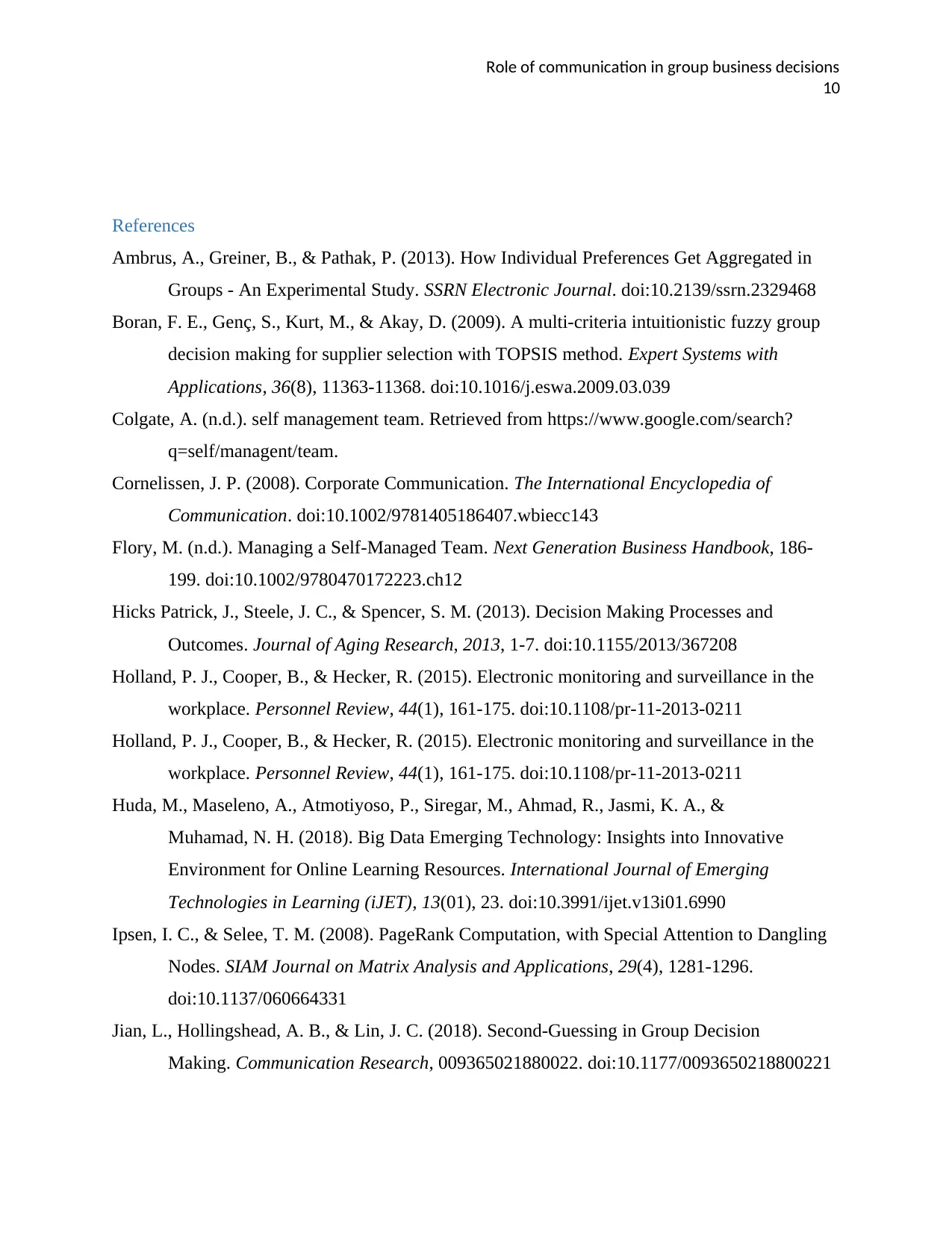
Role of communication in group business decisions
10
References
Ambrus, A., Greiner, B., & Pathak, P. (2013). How Individual Preferences Get Aggregated in
Groups - An Experimental Study. SSRN Electronic Journal. doi:10.2139/ssrn.2329468
Boran, F. E., Genç, S., Kurt, M., & Akay, D. (2009). A multi-criteria intuitionistic fuzzy group
decision making for supplier selection with TOPSIS method. Expert Systems with
Applications, 36(8), 11363-11368. doi:10.1016/j.eswa.2009.03.039
Colgate, A. (n.d.). self management team. Retrieved from https://www.google.com/search?
q=self/managent/team.
Cornelissen, J. P. (2008). Corporate Communication. The International Encyclopedia of
Communication. doi:10.1002/9781405186407.wbiecc143
Flory, M. (n.d.). Managing a Self-Managed Team. Next Generation Business Handbook, 186-
199. doi:10.1002/9780470172223.ch12
Hicks Patrick, J., Steele, J. C., & Spencer, S. M. (2013). Decision Making Processes and
Outcomes. Journal of Aging Research, 2013, 1-7. doi:10.1155/2013/367208
Holland, P. J., Cooper, B., & Hecker, R. (2015). Electronic monitoring and surveillance in the
workplace. Personnel Review, 44(1), 161-175. doi:10.1108/pr-11-2013-0211
Holland, P. J., Cooper, B., & Hecker, R. (2015). Electronic monitoring and surveillance in the
workplace. Personnel Review, 44(1), 161-175. doi:10.1108/pr-11-2013-0211
Huda, M., Maseleno, A., Atmotiyoso, P., Siregar, M., Ahmad, R., Jasmi, K. A., &
Muhamad, N. H. (2018). Big Data Emerging Technology: Insights into Innovative
Environment for Online Learning Resources. International Journal of Emerging
Technologies in Learning (iJET), 13(01), 23. doi:10.3991/ijet.v13i01.6990
Ipsen, I. C., & Selee, T. M. (2008). PageRank Computation, with Special Attention to Dangling
Nodes. SIAM Journal on Matrix Analysis and Applications, 29(4), 1281-1296.
doi:10.1137/060664331
Jian, L., Hollingshead, A. B., & Lin, J. C. (2018). Second-Guessing in Group Decision
Making. Communication Research, 009365021880022. doi:10.1177/0093650218800221
10
References
Ambrus, A., Greiner, B., & Pathak, P. (2013). How Individual Preferences Get Aggregated in
Groups - An Experimental Study. SSRN Electronic Journal. doi:10.2139/ssrn.2329468
Boran, F. E., Genç, S., Kurt, M., & Akay, D. (2009). A multi-criteria intuitionistic fuzzy group
decision making for supplier selection with TOPSIS method. Expert Systems with
Applications, 36(8), 11363-11368. doi:10.1016/j.eswa.2009.03.039
Colgate, A. (n.d.). self management team. Retrieved from https://www.google.com/search?
q=self/managent/team.
Cornelissen, J. P. (2008). Corporate Communication. The International Encyclopedia of
Communication. doi:10.1002/9781405186407.wbiecc143
Flory, M. (n.d.). Managing a Self-Managed Team. Next Generation Business Handbook, 186-
199. doi:10.1002/9780470172223.ch12
Hicks Patrick, J., Steele, J. C., & Spencer, S. M. (2013). Decision Making Processes and
Outcomes. Journal of Aging Research, 2013, 1-7. doi:10.1155/2013/367208
Holland, P. J., Cooper, B., & Hecker, R. (2015). Electronic monitoring and surveillance in the
workplace. Personnel Review, 44(1), 161-175. doi:10.1108/pr-11-2013-0211
Holland, P. J., Cooper, B., & Hecker, R. (2015). Electronic monitoring and surveillance in the
workplace. Personnel Review, 44(1), 161-175. doi:10.1108/pr-11-2013-0211
Huda, M., Maseleno, A., Atmotiyoso, P., Siregar, M., Ahmad, R., Jasmi, K. A., &
Muhamad, N. H. (2018). Big Data Emerging Technology: Insights into Innovative
Environment for Online Learning Resources. International Journal of Emerging
Technologies in Learning (iJET), 13(01), 23. doi:10.3991/ijet.v13i01.6990
Ipsen, I. C., & Selee, T. M. (2008). PageRank Computation, with Special Attention to Dangling
Nodes. SIAM Journal on Matrix Analysis and Applications, 29(4), 1281-1296.
doi:10.1137/060664331
Jian, L., Hollingshead, A. B., & Lin, J. C. (2018). Second-Guessing in Group Decision
Making. Communication Research, 009365021880022. doi:10.1177/0093650218800221
Paraphrase This Document
Need a fresh take? Get an instant paraphrase of this document with our AI Paraphraser
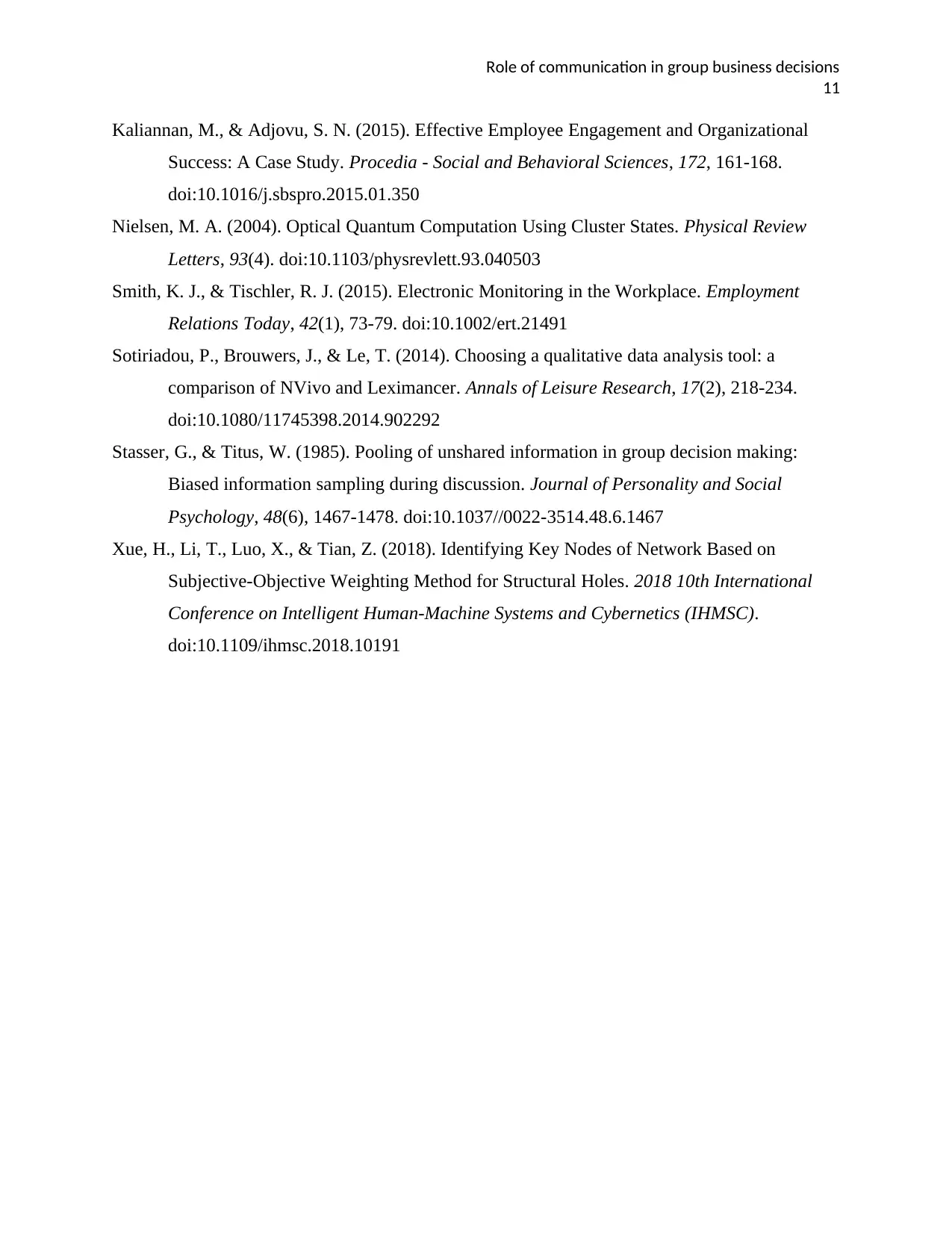
Role of communication in group business decisions
11
Kaliannan, M., & Adjovu, S. N. (2015). Effective Employee Engagement and Organizational
Success: A Case Study. Procedia - Social and Behavioral Sciences, 172, 161-168.
doi:10.1016/j.sbspro.2015.01.350
Nielsen, M. A. (2004). Optical Quantum Computation Using Cluster States. Physical Review
Letters, 93(4). doi:10.1103/physrevlett.93.040503
Smith, K. J., & Tischler, R. J. (2015). Electronic Monitoring in the Workplace. Employment
Relations Today, 42(1), 73-79. doi:10.1002/ert.21491
Sotiriadou, P., Brouwers, J., & Le, T. (2014). Choosing a qualitative data analysis tool: a
comparison of NVivo and Leximancer. Annals of Leisure Research, 17(2), 218-234.
doi:10.1080/11745398.2014.902292
Stasser, G., & Titus, W. (1985). Pooling of unshared information in group decision making:
Biased information sampling during discussion. Journal of Personality and Social
Psychology, 48(6), 1467-1478. doi:10.1037//0022-3514.48.6.1467
Xue, H., Li, T., Luo, X., & Tian, Z. (2018). Identifying Key Nodes of Network Based on
Subjective-Objective Weighting Method for Structural Holes. 2018 10th International
Conference on Intelligent Human-Machine Systems and Cybernetics (IHMSC).
doi:10.1109/ihmsc.2018.10191
11
Kaliannan, M., & Adjovu, S. N. (2015). Effective Employee Engagement and Organizational
Success: A Case Study. Procedia - Social and Behavioral Sciences, 172, 161-168.
doi:10.1016/j.sbspro.2015.01.350
Nielsen, M. A. (2004). Optical Quantum Computation Using Cluster States. Physical Review
Letters, 93(4). doi:10.1103/physrevlett.93.040503
Smith, K. J., & Tischler, R. J. (2015). Electronic Monitoring in the Workplace. Employment
Relations Today, 42(1), 73-79. doi:10.1002/ert.21491
Sotiriadou, P., Brouwers, J., & Le, T. (2014). Choosing a qualitative data analysis tool: a
comparison of NVivo and Leximancer. Annals of Leisure Research, 17(2), 218-234.
doi:10.1080/11745398.2014.902292
Stasser, G., & Titus, W. (1985). Pooling of unshared information in group decision making:
Biased information sampling during discussion. Journal of Personality and Social
Psychology, 48(6), 1467-1478. doi:10.1037//0022-3514.48.6.1467
Xue, H., Li, T., Luo, X., & Tian, Z. (2018). Identifying Key Nodes of Network Based on
Subjective-Objective Weighting Method for Structural Holes. 2018 10th International
Conference on Intelligent Human-Machine Systems and Cybernetics (IHMSC).
doi:10.1109/ihmsc.2018.10191
1 out of 11
Related Documents
Your All-in-One AI-Powered Toolkit for Academic Success.
+13062052269
info@desklib.com
Available 24*7 on WhatsApp / Email
![[object Object]](/_next/static/media/star-bottom.7253800d.svg)
Unlock your academic potential
Copyright © 2020–2025 A2Z Services. All Rights Reserved. Developed and managed by ZUCOL.





